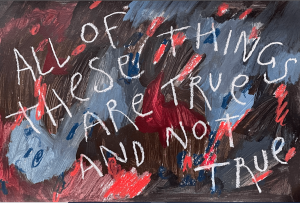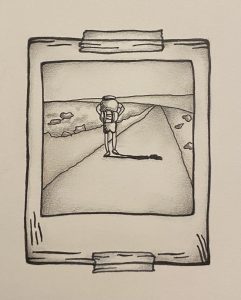
Invisible Wounds: The ISIS Undergoes Torture to Investigate ‘Enhanced Interrogation’
by James Rothwell | February 2, 2015
Content note: graphic description of torture
The noise is unbearable – a red ragged pulse which smothers the skin at every breath, the condensation soaking into the hood until it congeals over my nose and mouth and moulds itself into an oppressive black pall. My inner thighs are burning from the stress position I’ve been forced into, each leg frozen at right angles in the air, the feet and hands bound with duct tape. It scrapes and chokes the dry skin of my wrists, which – as I will later learn – are turning an alarming shade of red. A cocktail of white noise, industrial whirring, mechanical cacophony and sparse bursts of razor-sharp cackling are being pumped into my brain at an ear-splitting volume. I can’t remember how long it has been since the large stereo headphones cracked into life, but it feels like a million years.
It is the 12th January, 2011, and I am undergoing what the US government refers to as ‘enhanced interrogation’. I used to be complacent about the rumours of torture in the twenty-first century. The water-boarding scandals of the Bush Administration seemed to be history, and even though the hacked-off limbs of dissidents in China are a mere Google search away, torture has all but slipped back off the media’s radar. Yet even now, President Obama signs a bill indefinitely blocking the closure of Guantanamo Bay; extrajudicial renditions to the Middle East continue to operate; and nearly every month, a new lawsuit is filed against the British government, accusing it of complicity in torture abroad. The Western world may no longer be torturing terror suspects directly, but there is little doubt that countries with less stringent interrogation laws are doing their dirty work for them. Just ask Bisher Al-Rawi, whom the CIA transported to the so-called ‘Dark Prison’ in Afghanistan, and tortured for weeks on end.
I used to be your self-absorbed student, one of the teeming millions of passive spectators for whom human rights had played an ancillary role in the politics of the twenty-first century. I had no knowledge of torture whatsoever; it was a distant memory from a morally inferior period. I watched, unmoved, as more and more prisoners flowed into the CIA prisons, hovelled deep in the bowels of underground cells. It was easy. I reacted to any atrocity with a standard moral gag reflex, but my emotional attachment went no deeper than that.
That all changed.
Suddenly, I was sick of passivity and sick of watching coldly from the margins and sick of pouring vitriol on other countries’ policies from the safe distance of a comfortable armchair. So I started searching Oxford for someone audacious enough to torture me.
Of all the various torture methods, which include beatings, threats of rape and electrocution, the psychological ones are apparently the most devastatingly effective. For weeks on end you can torture someone just with music and all the damage is hidden, engraved on the inside of the victim’s skull. This fact was back to me on January 12th.
After weeks spent preparing and wading through a quagmire of legal obstacles, I find myself strapped into a different kind of chair, about to experience personally this latest weapon in the War on Terror. My colleague explains the procedure to me as he fastens the headphones over my head and binds them tighter and tighter against my skull with each twist of the duct tape. Suddenly I’m plunged into darkness as he roughly tugs over my head a balaclava that’s sewn together at the eyes and mouth, and spins me around to induce disorientation.
He asks me if I’m taking part in this experiment out of my own will.
“You are aware”, he adds, “that you can end the experiment at any time, by saying loudly and clearly the word ‘stop’?”
His words are muffled by the headphones, which are already echoing with the strange slosh of waves on the beach that one hears when pressing a conch shell close to the ear.
If he says anything after that, I can’t hear it, because my brain is swamped by the deafening drone of white noise. At first, it’s more irritating than traumatic: I try counting the seconds as they crawl by, but find it impossible to concentrate on anything other than the constant radio static, a deviant orchestra thrashing around inside my head. My thighs burn, but I can’t have been sitting here for more than ten minutes and I gruffly remind myself that real victims sit through dozens of hours of this. If my legs cramp up, or the shackles snap, the consequences are minimal; real victims are beaten so severely that they can’t even crawl back to their cells.
I’m just beginning to grow accustomed to the noise when the frequency dips violently, and then falls silent altogether. Once more I feel the conch shell waves lapping at my ears and I think I say out loud something like “this really isn’t so bad”, when there’s a loud burst of cackling, which swims deep into my head and makes every hair on my neck stand on end. Before long, I’m violently jerking my head to one side or the other each time the cackling leaps to one of its lunatic crescendos, in the futile hope that it might cushion the sonic blow. Then the track finally ends, and I momentarily feel a rush of relief, before the next track kicks in almost immediately: the nails-on-blackboard whining of babies crying on an endless loop.
These sharp bursts, which oscillate wildly in volume, suddenly give way to what I can only describe as ‘industrial noise’. It’s a haphazard combination of a mechanical drone, high-pitched wailing and the reverberating crashes of iron doorways slamming shut. My legs ache so intensely that I can barely keep them upright, and I allow them to press hard against my shackles to take some of the strain, even if that means cutting off more blood to my wrists.
I’m writhing in an entropic spiral of industrial noise, drunk and drowsy, trapped in some bizarre aural void: the nature of the experiment leads to sensory deprivation. I see nothing but blackness; feel nothing but the strain on my legs and the tape cutting into my wrists; hear nothing but the endless screech of the noise. It’s dictating the rhythm of my breathing and my thought processes, shaping my sense of reality.
Later. During another bout of the endless white noise, I start clapping my hands in order to create a rhythm to combat the perpetual nothingness in which my brain is drowning. I can’t hear my knuckles crunching against each other, but the vibrations shooting up my arms serve as something of a stabilising force. After a while, I become aware of a noise coming from outside the headphones: a harsh laughter. My colleague is ridiculing me. I can hear him howling away at the humiliating position I’ve been forced into, laughing with such vivacity that it’s easily audible over the white noise.
I stop clapping, hands reduced to shuddering clumps of flesh. The laughter can’t be coming from outside of the headphones – it’s that damn cackling again. Am I hallucinating? No: the tracks must be playing simultaneously. I’m just hearing both at the same time. The noise fades away and I relax for a moment. Then it gets much louder. I freeze. Somewhere, along the synapses of my brain, something has gone very wrong.
The next thing I know, my colleague has yanked the jack out of the music player and the warm comfort of the sea floods back into my brain. My head is tugged from left to right as he slices open the duct tape around my head, and removes the shackles. I feel sick. I lean forward blinded by the spotlight shining directly into my eyes, willing the room to stop spinning. My sense of time returns, along with all the other trappings of sanity.
“Why’d you stop the experiment?” I ask him.
“Why?” – he looks confused. “You started thrashing around and yelling stop, that’s why.” Later he explains that no one had been laughing at me. He was too busy monitoring the experiment to find anything vaguely humorous about it.
I won’t reveal how long I managed to endure the experiment for; it’s an embarrassingly short time-span compared to that to which rendition victims are subjected. Besides, it strikes me as bizarre to measure the true intensity of music torture in numerical terms: even a minute under the headphones is too long when you’re rapidly losing your sense of self.
Three days after the experiment, my colleague wanted to meet to see how my first draft of the article was going. I suspect he actually wanted to make sure I hadn’t thrown myself off a bridge.
“Do you regret doing this to yourself?” he asked me over a beer.
“No.”
He nodded, finished his drink and went to the jukebox.
“So what’ll it be?”
“I’d like The Cure,” I said, letting my head loll back on the seat, lost in a bad dream, and my colleague hit the button on the jukebox labelled ‘The Drowning Man’.
Image Boris Pitov




